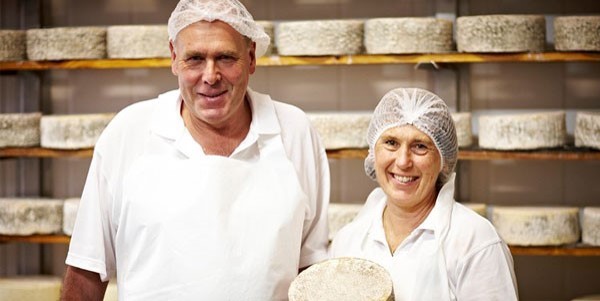Opening the Secrets of Artisanal Cheese Making: A Step-by-Step Do It Yourself Guide
In the world of cooking workmanship, artisanal cheese making stands as a testimony to the delicate balance in between custom and technology. As we embark on this journey to demystify the art of creating beautiful cheeses, we are faced with a tapestry of keys and abilities waiting to be unraveled.
Picking the Right Milk
When embarking on the trip of artisanal cheese making, the selection of milk plays an important role in identifying the high quality and qualities of the end product. The sort of milk selected impacts the flavor, texture, and overall account of celebrity. Raw milk, directly from the animal, is preferred by several artisanal cheesemakers as a result of its special blend of enzymes, bacteria, and flavor substances. Nevertheless, utilizing raw milk comes with guidelines and risks, making sterilized milk a much safer option for newbies.
When picking milk for cheese making, it is necessary to think about the fat content. Greater fat content in milk can lead to a creamier and richer cheese, while reduced fat material might result in a drier and stronger texture. In addition, the source of the milk, whether from cows, goats, sheep, or buffalo, adds distinct tastes and characteristics to the cheese (Melbourne Made Cheese). Each type of milk brings its very own subtleties, permitting a large range of cheese ranges to be crafted based upon the chosen milk. Eventually, the option of milk is a fundamental decision that establishes the structure for a successful artisanal cheese-making endeavor.
Culturing and Coagulating
To initiate the cheese-making process, the important actions of culturing and coagulating need to be meticulously executed to transform milk into curds and whey. Culturing involves introducing useful germs to the milk, which then begins the fermentation process. These germs convert lactose (milk sugar) into lactic acid, producing the acidic atmosphere required for coagulation. The type of culture used can considerably affect the flavor, texture, and ripening of the final cheese item.

The timing and temperature level control throughout culturing and coagulation are vital elements that influence the last outcome of celebrity. Appropriate execution of these actions is vital to guarantee the wanted structure, taste, and uniformity of the artisanal cheese being produced.
Draining Pipes and Pressing Curds
After the milk healthy proteins have coagulated and the curds have actually been cut to launch whey, the next vital action in artisanal cheese making entails draining and pushing the curds to accomplish the wanted structure and uniformity of the final cheese item. Draining pipes is the process of dividing the curds from the whey. This can be done by transferring the curds into a cheesecloth-lined bowl-shaped sieve or mold and permitting the whey to drain off normally. The moment for draining can differ depending on the sort of cheese being made and our website the wanted moisture material.
Pushing aids expel any remaining whey and compacts the curds to form a solid cheese wheel. Proper pushing and draining pipes are critical steps that considerably impact the quality and characteristics of the artisanal cheese being produced.
Aging and Flavoring Strategies
Applying thorough aging and flavor methods is essential in improving the depth and complexity of artisanal cheeses, boosting their preference accounts to beautiful degrees of improvement and class. Aging plays an important duty in establishing the one-of-a-kind tastes and structures that differentiate artisanal cheeses. During the aging procedure, cheeses are saved in very carefully managed environments where variables such as temperature level, air flow, and humidity are adjusted to motivate the growth of valuable molds and germs. This regulated environment permits the cheese to grow slowly, creating rich tastes and complicated fragrances.
Seasoning techniques likewise add significantly to the final preference of artisanal cheeses. Cheesemakers might choose to introduce extra tastes by incorporating components such as natural herbs, seasonings, and even fruits into the cheese throughout the manufacturing procedure. Additionally, some read more cheeses are washed or scrubed with numerous fluids, such as brine or alcohol, to enhance their flavors and structures.
Wrapping and Storing Cheeses

Conclusion
In verdict, grasping the art of artisanal cheese making involves very carefully choosing the best milk, complying with exact culturing and coagulating procedures, draining and pressing curds effectively, and utilizing various aging and flavoring strategies. By adhering to these actions diligently and with attention to information, you can develop your very own tasty and distinct cheeses in the house. Bear in mind to cover and keep your cheeses effectively to make certain optimum taste and texture development. Happy cheese making!
official source
Each kind of milk brings its very own nuances, enabling for a broad array of cheese varieties to be crafted based on the selected milk.After the milk proteins have coagulated and the curds have been reduced to release whey, the next important step in artisanal cheese making includes draining and pressing the curds to accomplish the desired appearance and uniformity of the final cheese item. Most cheeses need to be wrapped in wax paper or cheese paper to allow them to breathe while shielding them from drying out. For cheeses that require to continue aging, such as bloomy peels or cleaned rinds, guarantee they are saved in an awesome setting like a cheese cavern or a refrigerator set to the proper temperature. By paying focus to the wrapping and storage space of artisanal cheeses, cheese manufacturers and enthusiasts can maintain the stability of these specials and fully enjoy their complicated tastes.